Business and Business Environment Report: Asda Analysis - HND, Unit 1
VerifiedAdded on 2023/01/10
|19
|4643
|29
Report
AI Summary
This report provides a comprehensive analysis of the business environment, examining different types of organizations, their purposes, and legal structures. It delves into the size and scope of various organizational types, exploring the relationships between different organizational functions such as HRM, marketing, IT, production, finance, and R&D. The report investigates the impact of the macro environment on business activities, utilizing PESTLE analysis to assess political, economic, social, technological, legal, and environmental factors. Furthermore, it includes an internal and external analysis of Asda, employing SWOT analysis to evaluate its strengths, weaknesses, opportunities, and threats, particularly in relation to the macro environment. The report also discusses different organizational structures, such as tall and flat structures, outlining their advantages and disadvantages. Overall, the report aims to evaluate factors influencing Asda's performance within the retail market, offering valuable insights into business operations and strategies.
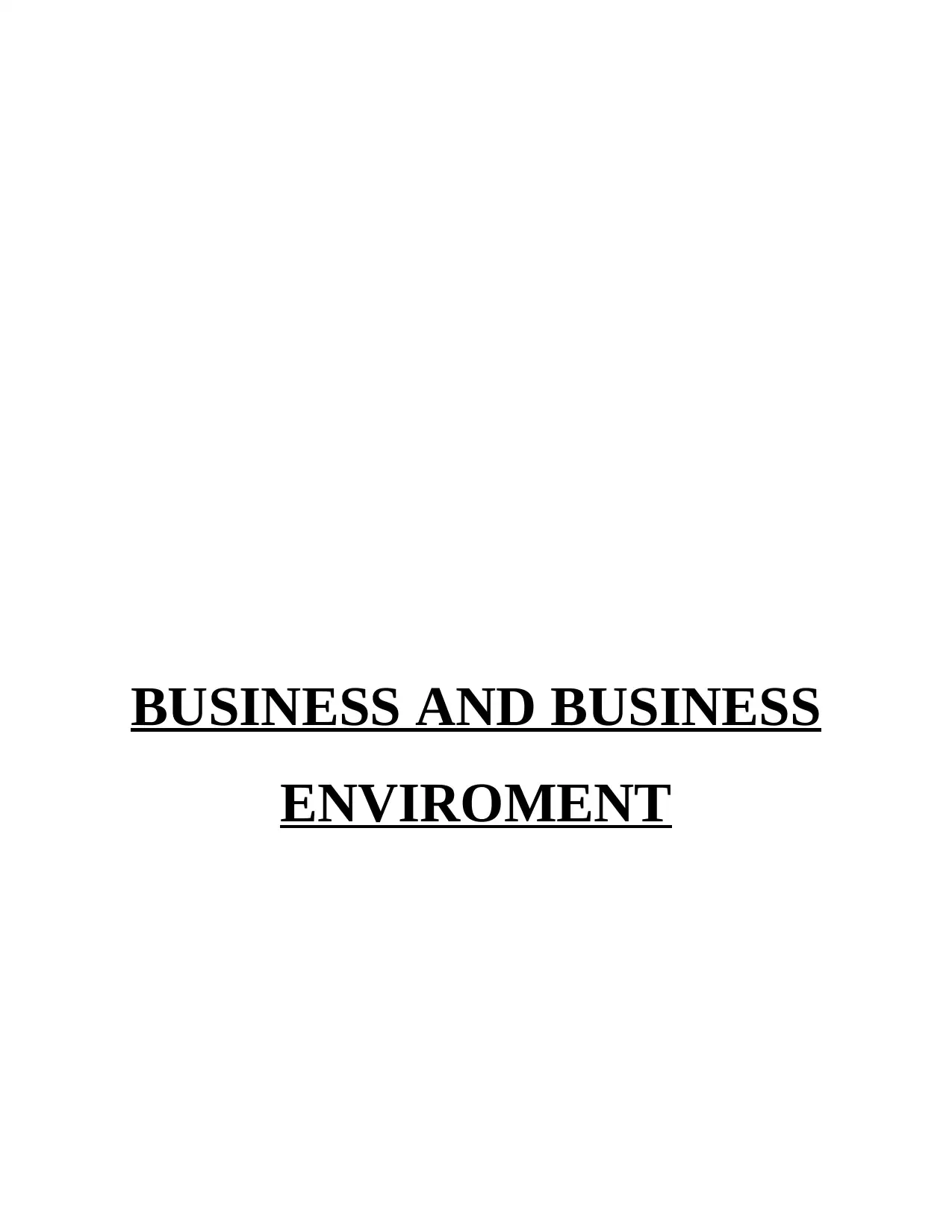
BUSINESS AND BUSINESS
ENVIROMENT
ENVIROMENT
Paraphrase This Document
Need a fresh take? Get an instant paraphrase of this document with our AI Paraphraser
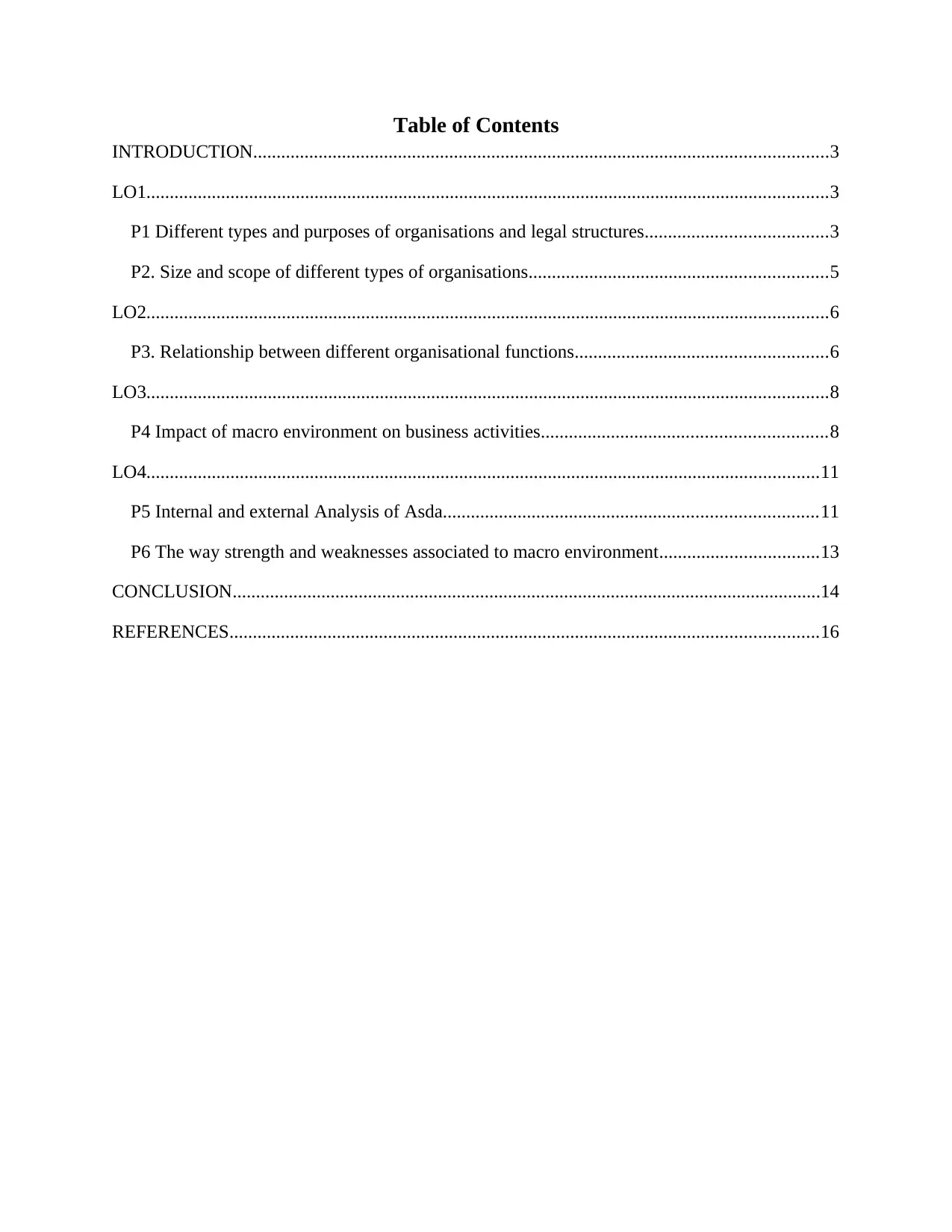
Table of Contents
INTRODUCTION...........................................................................................................................3
LO1..................................................................................................................................................3
P1 Different types and purposes of organisations and legal structures.......................................3
P2. Size and scope of different types of organisations................................................................5
LO2..................................................................................................................................................6
P3. Relationship between different organisational functions......................................................6
LO3..................................................................................................................................................8
P4 Impact of macro environment on business activities.............................................................8
LO4................................................................................................................................................11
P5 Internal and external Analysis of Asda................................................................................11
P6 The way strength and weaknesses associated to macro environment..................................13
CONCLUSION..............................................................................................................................14
REFERENCES..............................................................................................................................16
INTRODUCTION...........................................................................................................................3
LO1..................................................................................................................................................3
P1 Different types and purposes of organisations and legal structures.......................................3
P2. Size and scope of different types of organisations................................................................5
LO2..................................................................................................................................................6
P3. Relationship between different organisational functions......................................................6
LO3..................................................................................................................................................8
P4 Impact of macro environment on business activities.............................................................8
LO4................................................................................................................................................11
P5 Internal and external Analysis of Asda................................................................................11
P6 The way strength and weaknesses associated to macro environment..................................13
CONCLUSION..............................................................................................................................14
REFERENCES..............................................................................................................................16
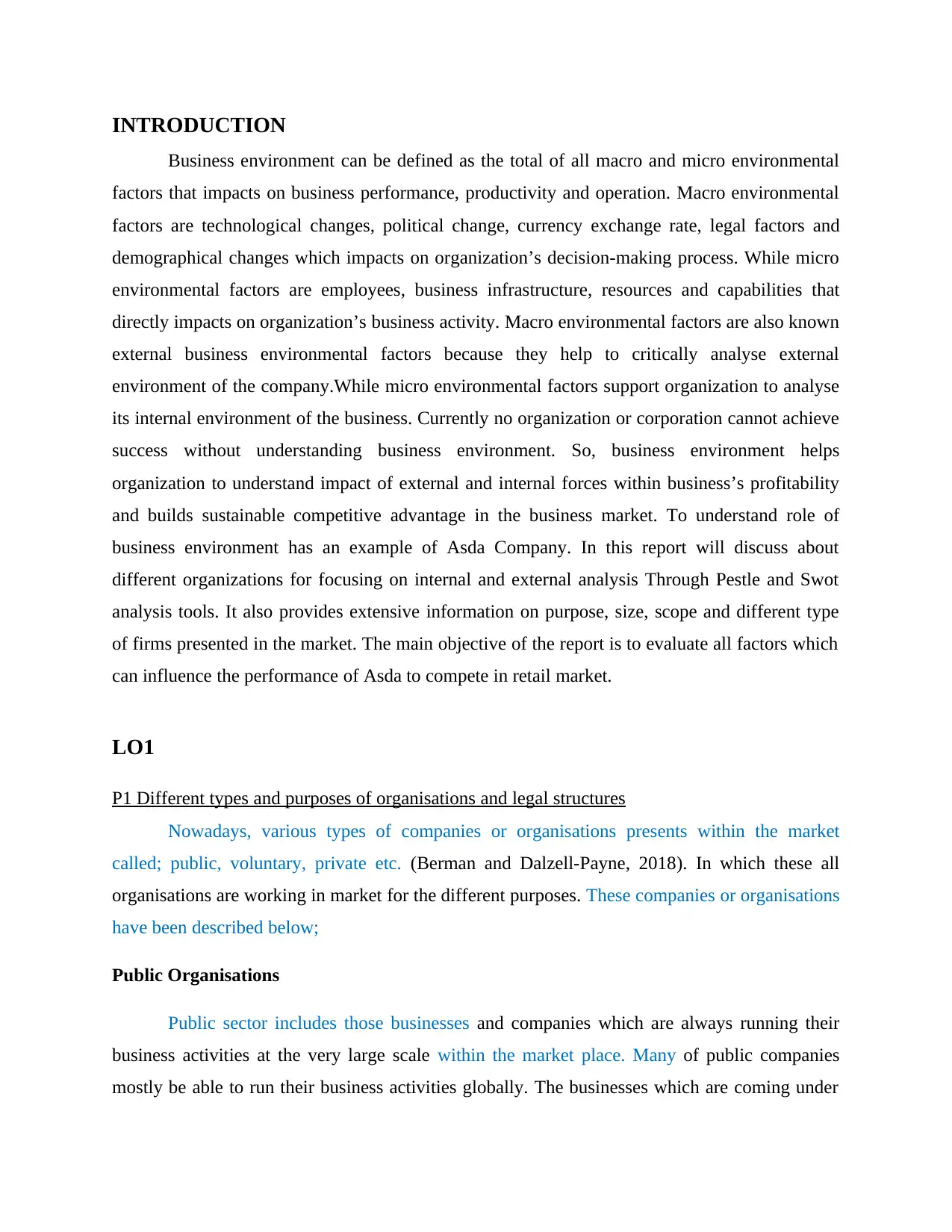
INTRODUCTION
Business environment can be defined as the total of all macro and micro environmental
factors that impacts on business performance, productivity and operation. Macro environmental
factors are technological changes, political change, currency exchange rate, legal factors and
demographical changes which impacts on organization’s decision-making process. While micro
environmental factors are employees, business infrastructure, resources and capabilities that
directly impacts on organization’s business activity. Macro environmental factors are also known
external business environmental factors because they help to critically analyse external
environment of the company.While micro environmental factors support organization to analyse
its internal environment of the business. Currently no organization or corporation cannot achieve
success without understanding business environment. So, business environment helps
organization to understand impact of external and internal forces within business’s profitability
and builds sustainable competitive advantage in the business market. To understand role of
business environment has an example of Asda Company. In this report will discuss about
different organizations for focusing on internal and external analysis Through Pestle and Swot
analysis tools. It also provides extensive information on purpose, size, scope and different type
of firms presented in the market. The main objective of the report is to evaluate all factors which
can influence the performance of Asda to compete in retail market.
LO1
P1 Different types and purposes of organisations and legal structures
Nowadays, various types of companies or organisations presents within the market
called; public, voluntary, private etc. (Berman and Dalzell-Payne, 2018). In which these all
organisations are working in market for the different purposes. These companies or organisations
have been described below;
Public Organisations
Public sector includes those businesses and companies which are always running their
business activities at the very large scale within the market place. Many of public companies
mostly be able to run their business activities globally. The businesses which are coming under
Business environment can be defined as the total of all macro and micro environmental
factors that impacts on business performance, productivity and operation. Macro environmental
factors are technological changes, political change, currency exchange rate, legal factors and
demographical changes which impacts on organization’s decision-making process. While micro
environmental factors are employees, business infrastructure, resources and capabilities that
directly impacts on organization’s business activity. Macro environmental factors are also known
external business environmental factors because they help to critically analyse external
environment of the company.While micro environmental factors support organization to analyse
its internal environment of the business. Currently no organization or corporation cannot achieve
success without understanding business environment. So, business environment helps
organization to understand impact of external and internal forces within business’s profitability
and builds sustainable competitive advantage in the business market. To understand role of
business environment has an example of Asda Company. In this report will discuss about
different organizations for focusing on internal and external analysis Through Pestle and Swot
analysis tools. It also provides extensive information on purpose, size, scope and different type
of firms presented in the market. The main objective of the report is to evaluate all factors which
can influence the performance of Asda to compete in retail market.
LO1
P1 Different types and purposes of organisations and legal structures
Nowadays, various types of companies or organisations presents within the market
called; public, voluntary, private etc. (Berman and Dalzell-Payne, 2018). In which these all
organisations are working in market for the different purposes. These companies or organisations
have been described below;
Public Organisations
Public sector includes those businesses and companies which are always running their
business activities at the very large scale within the market place. Many of public companies
mostly be able to run their business activities globally. The businesses which are coming under
⊘ This is a preview!⊘
Do you want full access?
Subscribe today to unlock all pages.

Trusted by 1+ million students worldwide

the public industry or sector are selling their shares publicly, in which people in market place can
easily buy shares of a public venture, Public organisations always need high technology within
their daily business activities. The main reason is, these organisations run activities at the very
large scale within market place.
Private Organisations
Private organisations or companies mostly have something minimum scope than public
organisations. Most of private organisations run own activitiesat the national and regional level,
because nowadays, only few private organisations exist within the UK which runs their business
operations internationally. Companies in private sector never sell their shares publicly, because
owners within these companies mainly offers their shares to people who has close to them, like;
family members and friend sets. Private organisations are also always required for employing
technology, however not too excellent technology as public companies used.
Voluntary Organisations
Voluntary organisations always run their activities or operations in very low level of
scale in market. Voluntary organisations have mostly expanded their operations according to
their cash and fund inflow (Holmqvist and Ruiz,2017). Suppose, when any organisation of
voluntary sectorgains high fund by donation and charity, then they can easily be expanded their
services globally. Social organisations no have very high involvement of differentshareholders,
because these organisations are not working for earning effective profit margin. A voluntary
organisation raise fund only through donation and charity.
Legal Structure
Different types of organisations arehighly responsible to follow various considerations of
laws and ethics which has formulated by the United Kingdom’sgovernment. Some prime or
keyconsiderations of law and ethics have been mentioned below which each organisation should
be followed within its regular or daily operations.
Partnership act (1890):On the basis of this act of partnership, when there are two and more than
two persons ready for beginning a venture or organisation, then these persons are fully
responsible to register their new organisation legally within the country. There are this is very
easily buy shares of a public venture, Public organisations always need high technology within
their daily business activities. The main reason is, these organisations run activities at the very
large scale within market place.
Private Organisations
Private organisations or companies mostly have something minimum scope than public
organisations. Most of private organisations run own activitiesat the national and regional level,
because nowadays, only few private organisations exist within the UK which runs their business
operations internationally. Companies in private sector never sell their shares publicly, because
owners within these companies mainly offers their shares to people who has close to them, like;
family members and friend sets. Private organisations are also always required for employing
technology, however not too excellent technology as public companies used.
Voluntary Organisations
Voluntary organisations always run their activities or operations in very low level of
scale in market. Voluntary organisations have mostly expanded their operations according to
their cash and fund inflow (Holmqvist and Ruiz,2017). Suppose, when any organisation of
voluntary sectorgains high fund by donation and charity, then they can easily be expanded their
services globally. Social organisations no have very high involvement of differentshareholders,
because these organisations are not working for earning effective profit margin. A voluntary
organisation raise fund only through donation and charity.
Legal Structure
Different types of organisations arehighly responsible to follow various considerations of
laws and ethics which has formulated by the United Kingdom’sgovernment. Some prime or
keyconsiderations of law and ethics have been mentioned below which each organisation should
be followed within its regular or daily operations.
Partnership act (1890):On the basis of this act of partnership, when there are two and more than
two persons ready for beginning a venture or organisation, then these persons are fully
responsible to register their new organisation legally within the country. There are this is very
Paraphrase This Document
Need a fresh take? Get an instant paraphrase of this document with our AI Paraphraser

important act, because it has given opportunity for removing various conflicts between people or
partners. Nowadays, most partnership ventures and organisations has successfully operated their
activities within the UK with the help of this act of partnership.
Companies act 2006:This companies act is next key act to different companies or organisations
within the country. There is this act provide opportunity to various people to choose their
company’s category according to their business structure (Renand et.al., 2017). This act has
mainly categorised various ventures in two main categories; the private limited company and the
public limited company.
Employment law:Companies and organisations under all sectors (private, public, voluntary)
highly responsible to consider the law employment within their daily operations. Generally,
employment law has passed through the United Kingdom’s government in the welfare of various
employees, that’s why this is too important legal term.
Sole trader: A sole trader is basically a person who exclusively owns a venture or business.
According to UK’s business law, a sole trader has always right to keep the full profit of business
after fulfilling taxation formalities.
Private limited company: A private limited company never sells its shares publicly, and this type
of companies always has minimum scope than a public company.
Public limited company: A public limited company always sells it shares publicly, so that any
person can easily buy shares of public companies within the market.
Cooperatives: A cooperative organisation always formulates, when minimum two
people/members or two organisations come together for achieving decided objectives.
Voluntary organisation: Voluntary organisation runs by different people or companies for
working in the social welfare. Mainly organisers of organisation invest fund this type
organisations.
Charitable organisation: A charitable trust always raise fund through by charity and donation.
These organisations also work in public welfare.
partners. Nowadays, most partnership ventures and organisations has successfully operated their
activities within the UK with the help of this act of partnership.
Companies act 2006:This companies act is next key act to different companies or organisations
within the country. There is this act provide opportunity to various people to choose their
company’s category according to their business structure (Renand et.al., 2017). This act has
mainly categorised various ventures in two main categories; the private limited company and the
public limited company.
Employment law:Companies and organisations under all sectors (private, public, voluntary)
highly responsible to consider the law employment within their daily operations. Generally,
employment law has passed through the United Kingdom’s government in the welfare of various
employees, that’s why this is too important legal term.
Sole trader: A sole trader is basically a person who exclusively owns a venture or business.
According to UK’s business law, a sole trader has always right to keep the full profit of business
after fulfilling taxation formalities.
Private limited company: A private limited company never sells its shares publicly, and this type
of companies always has minimum scope than a public company.
Public limited company: A public limited company always sells it shares publicly, so that any
person can easily buy shares of public companies within the market.
Cooperatives: A cooperative organisation always formulates, when minimum two
people/members or two organisations come together for achieving decided objectives.
Voluntary organisation: Voluntary organisation runs by different people or companies for
working in the social welfare. Mainly organisers of organisation invest fund this type
organisations.
Charitable organisation: A charitable trust always raise fund through by charity and donation.
These organisations also work in public welfare.
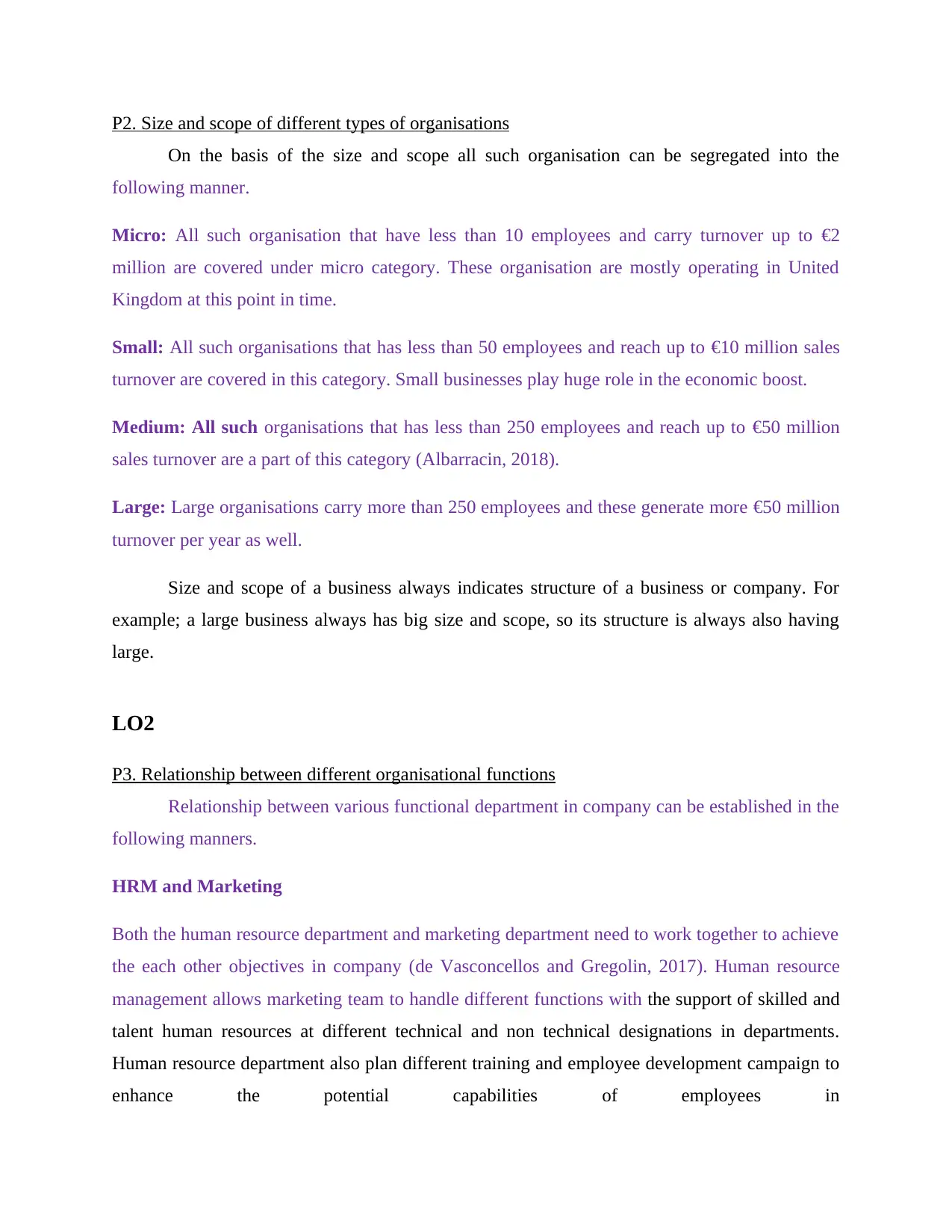
P2. Size and scope of different types of organisations
On the basis of the size and scope all such organisation can be segregated into the
following manner.
Micro: All such organisation that have less than 10 employees and carry turnover up to €2
million are covered under micro category. These organisation are mostly operating in United
Kingdom at this point in time.
Small: All such organisations that has less than 50 employees and reach up to €10 million sales
turnover are covered in this category. Small businesses play huge role in the economic boost.
Medium: All such organisations that has less than 250 employees and reach up to €50 million
sales turnover are a part of this category (Albarracin, 2018).
Large: Large organisations carry more than 250 employees and these generate more €50 million
turnover per year as well.
Size and scope of a business always indicates structure of a business or company. For
example; a large business always has big size and scope, so its structure is always also having
large.
LO2
P3. Relationship between different organisational functions
Relationship between various functional department in company can be established in the
following manners.
HRM and Marketing
Both the human resource department and marketing department need to work together to achieve
the each other objectives in company (de Vasconcellos and Gregolin, 2017). Human resource
management allows marketing team to handle different functions with the support of skilled and
talent human resources at different technical and non technical designations in departments.
Human resource department also plan different training and employee development campaign to
enhance the potential capabilities of employees in
On the basis of the size and scope all such organisation can be segregated into the
following manner.
Micro: All such organisation that have less than 10 employees and carry turnover up to €2
million are covered under micro category. These organisation are mostly operating in United
Kingdom at this point in time.
Small: All such organisations that has less than 50 employees and reach up to €10 million sales
turnover are covered in this category. Small businesses play huge role in the economic boost.
Medium: All such organisations that has less than 250 employees and reach up to €50 million
sales turnover are a part of this category (Albarracin, 2018).
Large: Large organisations carry more than 250 employees and these generate more €50 million
turnover per year as well.
Size and scope of a business always indicates structure of a business or company. For
example; a large business always has big size and scope, so its structure is always also having
large.
LO2
P3. Relationship between different organisational functions
Relationship between various functional department in company can be established in the
following manners.
HRM and Marketing
Both the human resource department and marketing department need to work together to achieve
the each other objectives in company (de Vasconcellos and Gregolin, 2017). Human resource
management allows marketing team to handle different functions with the support of skilled and
talent human resources at different technical and non technical designations in departments.
Human resource department also plan different training and employee development campaign to
enhance the potential capabilities of employees in
⊘ This is a preview!⊘
Do you want full access?
Subscribe today to unlock all pages.

Trusted by 1+ million students worldwide
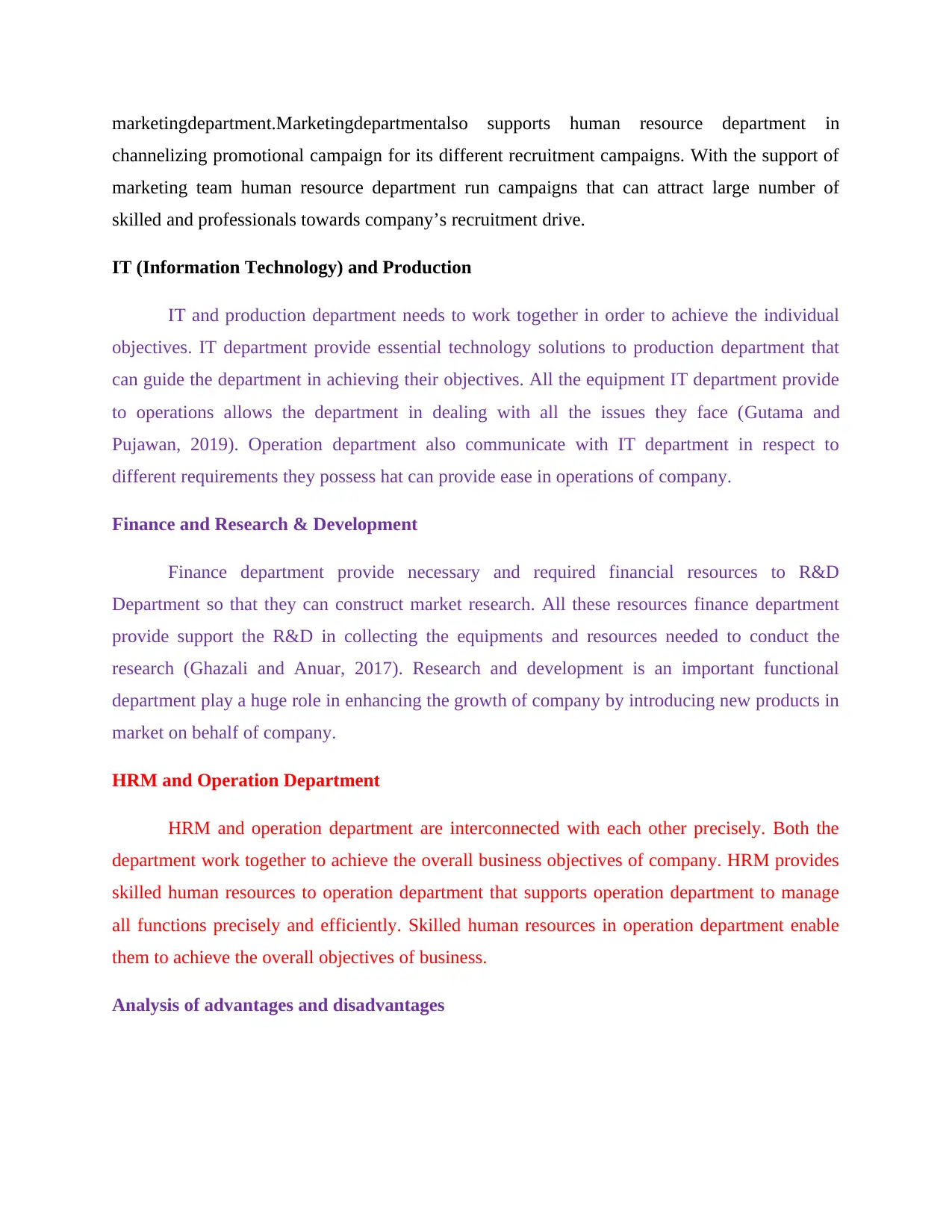
marketingdepartment.Marketingdepartmentalso supports human resource department in
channelizing promotional campaign for its different recruitment campaigns. With the support of
marketing team human resource department run campaigns that can attract large number of
skilled and professionals towards company’s recruitment drive.
IT (Information Technology) and Production
IT and production department needs to work together in order to achieve the individual
objectives. IT department provide essential technology solutions to production department that
can guide the department in achieving their objectives. All the equipment IT department provide
to operations allows the department in dealing with all the issues they face (Gutama and
Pujawan, 2019). Operation department also communicate with IT department in respect to
different requirements they possess hat can provide ease in operations of company.
Finance and Research & Development
Finance department provide necessary and required financial resources to R&D
Department so that they can construct market research. All these resources finance department
provide support the R&D in collecting the equipments and resources needed to conduct the
research (Ghazali and Anuar, 2017). Research and development is an important functional
department play a huge role in enhancing the growth of company by introducing new products in
market on behalf of company.
HRM and Operation Department
HRM and operation department are interconnected with each other precisely. Both the
department work together to achieve the overall business objectives of company. HRM provides
skilled human resources to operation department that supports operation department to manage
all functions precisely and efficiently. Skilled human resources in operation department enable
them to achieve the overall objectives of business.
Analysis of advantages and disadvantages
channelizing promotional campaign for its different recruitment campaigns. With the support of
marketing team human resource department run campaigns that can attract large number of
skilled and professionals towards company’s recruitment drive.
IT (Information Technology) and Production
IT and production department needs to work together in order to achieve the individual
objectives. IT department provide essential technology solutions to production department that
can guide the department in achieving their objectives. All the equipment IT department provide
to operations allows the department in dealing with all the issues they face (Gutama and
Pujawan, 2019). Operation department also communicate with IT department in respect to
different requirements they possess hat can provide ease in operations of company.
Finance and Research & Development
Finance department provide necessary and required financial resources to R&D
Department so that they can construct market research. All these resources finance department
provide support the R&D in collecting the equipments and resources needed to conduct the
research (Ghazali and Anuar, 2017). Research and development is an important functional
department play a huge role in enhancing the growth of company by introducing new products in
market on behalf of company.
HRM and Operation Department
HRM and operation department are interconnected with each other precisely. Both the
department work together to achieve the overall business objectives of company. HRM provides
skilled human resources to operation department that supports operation department to manage
all functions precisely and efficiently. Skilled human resources in operation department enable
them to achieve the overall objectives of business.
Analysis of advantages and disadvantages
Paraphrase This Document
Need a fresh take? Get an instant paraphrase of this document with our AI Paraphraser

Relationship between functional department play huge role for the company in achieving
the overall objectives of company. Individual functional departments need to communicate with
other operational department in relation to the working outcomes from such departments.
Organisation structure
Tall structure
Following benefits and disadvantages are associated with the tall structure
Advantages
This structure provides systematic flow of operation functions in organisation.
Decentralised process
All teams are segregated as per the needs of the structure.
Disadvantages
Old concepts of organisation structure.
the overall objectives of company. Individual functional departments need to communicate with
other operational department in relation to the working outcomes from such departments.
Organisation structure
Tall structure
Following benefits and disadvantages are associated with the tall structure
Advantages
This structure provides systematic flow of operation functions in organisation.
Decentralised process
All teams are segregated as per the needs of the structure.
Disadvantages
Old concepts of organisation structure.
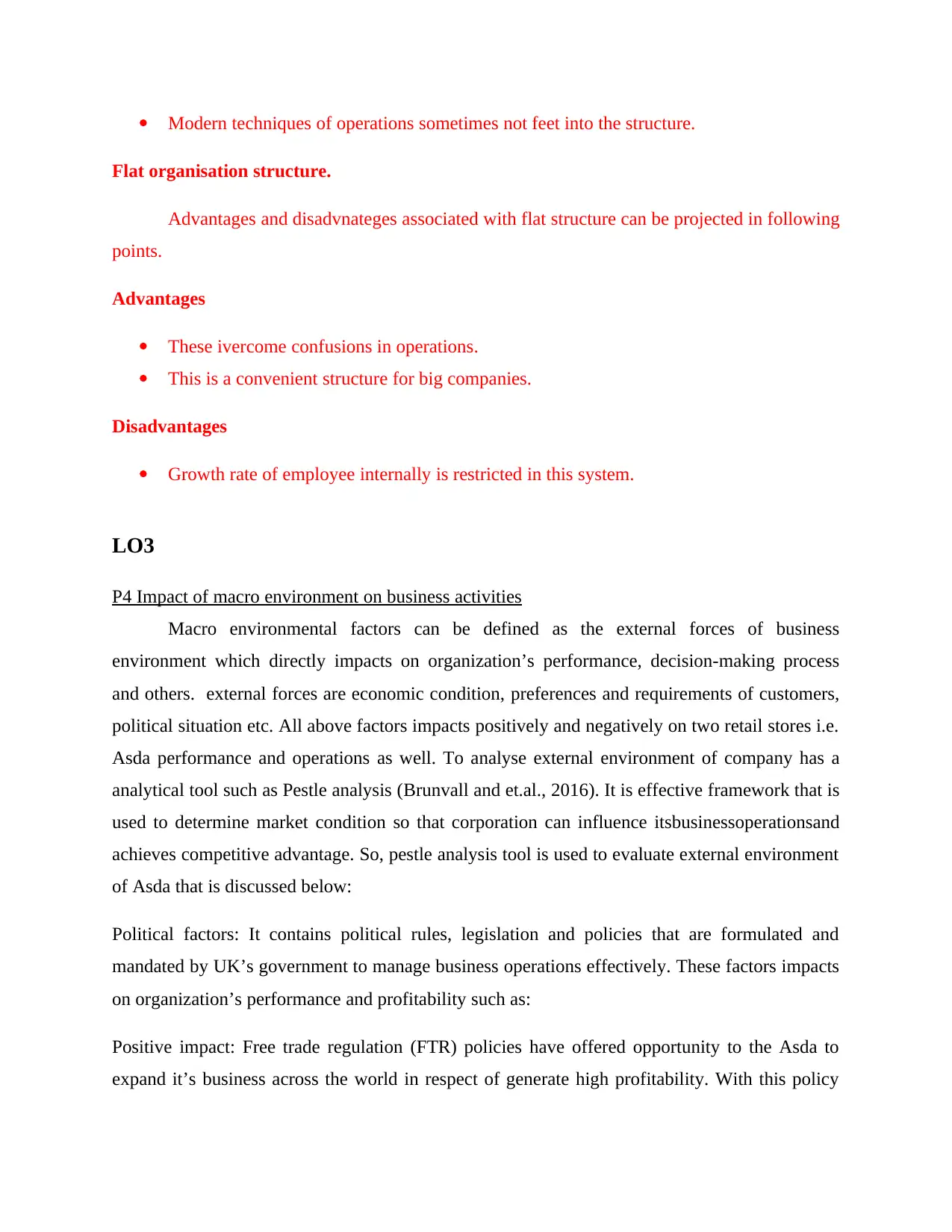
Modern techniques of operations sometimes not feet into the structure.
Flat organisation structure.
Advantages and disadvnateges associated with flat structure can be projected in following
points.
Advantages
These ivercome confusions in operations.
This is a convenient structure for big companies.
Disadvantages
Growth rate of employee internally is restricted in this system.
LO3
P4 Impact of macro environment on business activities
Macro environmental factors can be defined as the external forces of business
environment which directly impacts on organization’s performance, decision-making process
and others. external forces are economic condition, preferences and requirements of customers,
political situation etc. All above factors impacts positively and negatively on two retail stores i.e.
Asda performance and operations as well. To analyse external environment of company has a
analytical tool such as Pestle analysis (Brunvall and et.al., 2016). It is effective framework that is
used to determine market condition so that corporation can influence itsbusinessoperationsand
achieves competitive advantage. So, pestle analysis tool is used to evaluate external environment
of Asda that is discussed below:
Political factors: It contains political rules, legislation and policies that are formulated and
mandated by UK’s government to manage business operations effectively. These factors impacts
on organization’s performance and profitability such as:
Positive impact: Free trade regulation (FTR) policies have offered opportunity to the Asda to
expand it’s business across the world in respect of generate high profitability. With this policy
Flat organisation structure.
Advantages and disadvnateges associated with flat structure can be projected in following
points.
Advantages
These ivercome confusions in operations.
This is a convenient structure for big companies.
Disadvantages
Growth rate of employee internally is restricted in this system.
LO3
P4 Impact of macro environment on business activities
Macro environmental factors can be defined as the external forces of business
environment which directly impacts on organization’s performance, decision-making process
and others. external forces are economic condition, preferences and requirements of customers,
political situation etc. All above factors impacts positively and negatively on two retail stores i.e.
Asda performance and operations as well. To analyse external environment of company has a
analytical tool such as Pestle analysis (Brunvall and et.al., 2016). It is effective framework that is
used to determine market condition so that corporation can influence itsbusinessoperationsand
achieves competitive advantage. So, pestle analysis tool is used to evaluate external environment
of Asda that is discussed below:
Political factors: It contains political rules, legislation and policies that are formulated and
mandated by UK’s government to manage business operations effectively. These factors impacts
on organization’s performance and profitability such as:
Positive impact: Free trade regulation (FTR) policies have offered opportunity to the Asda to
expand it’s business across the world in respect of generate high profitability. With this policy
⊘ This is a preview!⊘
Do you want full access?
Subscribe today to unlock all pages.

Trusted by 1+ million students worldwide
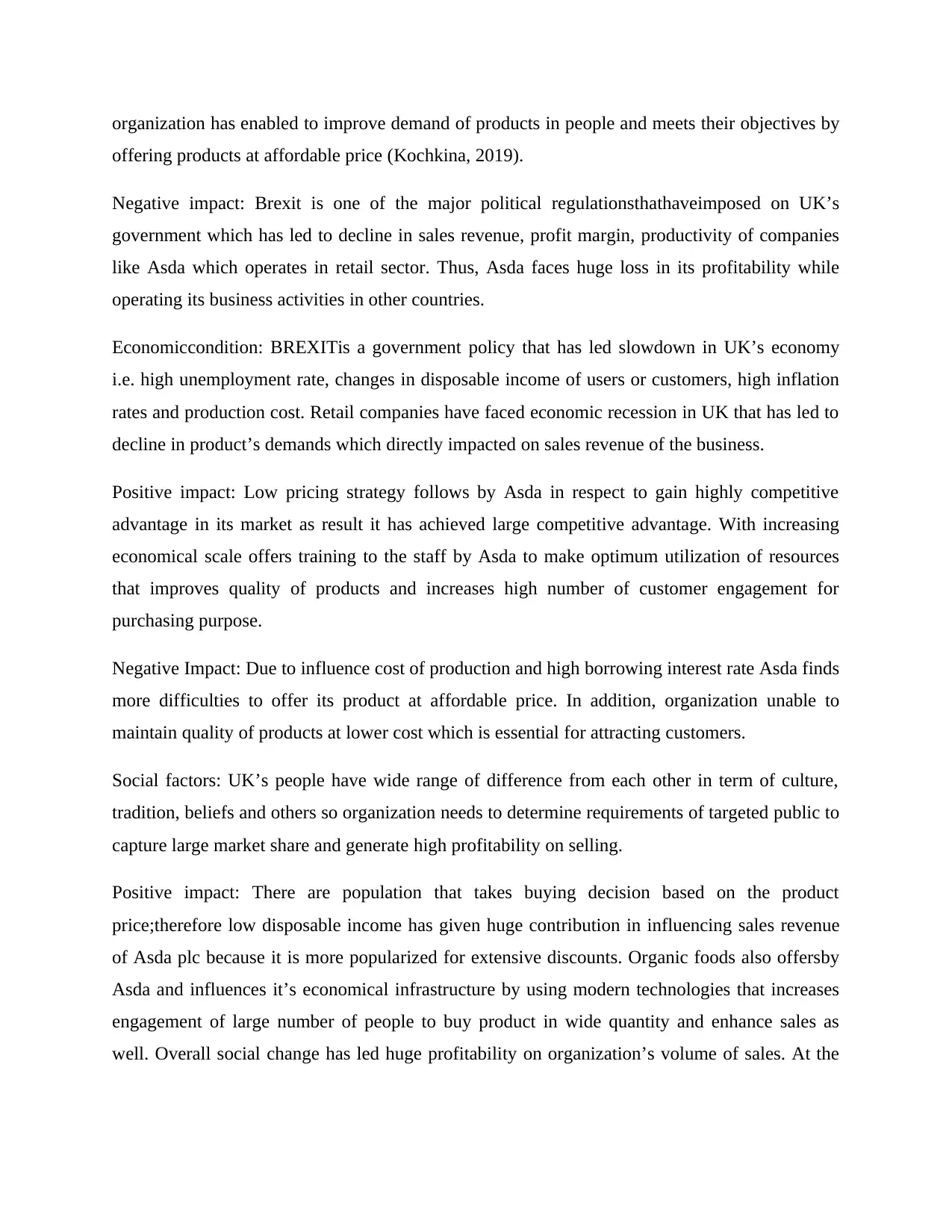
organization has enabled to improve demand of products in people and meets their objectives by
offering products at affordable price (Kochkina, 2019).
Negative impact: Brexit is one of the major political regulationsthathaveimposed on UK’s
government which has led to decline in sales revenue, profit margin, productivity of companies
like Asda which operates in retail sector. Thus, Asda faces huge loss in its profitability while
operating its business activities in other countries.
Economiccondition: BREXITis a government policy that has led slowdown in UK’s economy
i.e. high unemployment rate, changes in disposable income of users or customers, high inflation
rates and production cost. Retail companies have faced economic recession in UK that has led to
decline in product’s demands which directly impacted on sales revenue of the business.
Positive impact: Low pricing strategy follows by Asda in respect to gain highly competitive
advantage in its market as result it has achieved large competitive advantage. With increasing
economical scale offers training to the staff by Asda to make optimum utilization of resources
that improves quality of products and increases high number of customer engagement for
purchasing purpose.
Negative Impact: Due to influence cost of production and high borrowing interest rate Asda finds
more difficulties to offer its product at affordable price. In addition, organization unable to
maintain quality of products at lower cost which is essential for attracting customers.
Social factors: UK’s people have wide range of difference from each other in term of culture,
tradition, beliefs and others so organization needs to determine requirements of targeted public to
capture large market share and generate high profitability on selling.
Positive impact: There are population that takes buying decision based on the product
price;therefore low disposable income has given huge contribution in influencing sales revenue
of Asda plc because it is more popularized for extensive discounts. Organic foods also offersby
Asda and influences it’s economical infrastructure by using modern technologies that increases
engagement of large number of people to buy product in wide quantity and enhance sales as
well. Overall social change has led huge profitability on organization’s volume of sales. At the
offering products at affordable price (Kochkina, 2019).
Negative impact: Brexit is one of the major political regulationsthathaveimposed on UK’s
government which has led to decline in sales revenue, profit margin, productivity of companies
like Asda which operates in retail sector. Thus, Asda faces huge loss in its profitability while
operating its business activities in other countries.
Economiccondition: BREXITis a government policy that has led slowdown in UK’s economy
i.e. high unemployment rate, changes in disposable income of users or customers, high inflation
rates and production cost. Retail companies have faced economic recession in UK that has led to
decline in product’s demands which directly impacted on sales revenue of the business.
Positive impact: Low pricing strategy follows by Asda in respect to gain highly competitive
advantage in its market as result it has achieved large competitive advantage. With increasing
economical scale offers training to the staff by Asda to make optimum utilization of resources
that improves quality of products and increases high number of customer engagement for
purchasing purpose.
Negative Impact: Due to influence cost of production and high borrowing interest rate Asda finds
more difficulties to offer its product at affordable price. In addition, organization unable to
maintain quality of products at lower cost which is essential for attracting customers.
Social factors: UK’s people have wide range of difference from each other in term of culture,
tradition, beliefs and others so organization needs to determine requirements of targeted public to
capture large market share and generate high profitability on selling.
Positive impact: There are population that takes buying decision based on the product
price;therefore low disposable income has given huge contribution in influencing sales revenue
of Asda plc because it is more popularized for extensive discounts. Organic foods also offersby
Asda and influences it’s economical infrastructure by using modern technologies that increases
engagement of large number of people to buy product in wide quantity and enhance sales as
well. Overall social change has led huge profitability on organization’s volume of sales. At the
Paraphrase This Document
Need a fresh take? Get an instant paraphrase of this document with our AI Paraphraser

same time production cots of organic and new products have increased that has impacted on
profit margin of products negatively (Bîrsan, Shuleskiand Cristea, V., 2016).
Negative Impact: Tesco has strong brand positioning and high level of satisfaction that has given
a challenge to Asda to influence its business activities in its market and influence people to buy
product that lives in UK. There are some people who think that Asda offers fewer quality
products so it had to influence its brand positing to generate maximum profitability.
Technological factors: Changes in technology, emerging technology etc. are technological
factors. Adaption of technological changes important for the organization in order to achieve
high competitive advantage and offers best and qualitative experienced.
Positive impact: Modern technologies like social media has used by Asda to sell its products and
services for attracting large group of people who are staying in multiple countries around the
world. So, it supports in influencing sales, profitability and decline cost for marketing its goods
and services thus played effective role towards minimizing input and increasing output for
growth and success perspective of corporation. Online home delivery services are also offered by
Asda to influence shopping experience of customers as well as increase customer’s satisfaction
and loyalty for the brand and its products. Thus, organization has promoted growth and
expansion of business in various countries successfully (Jiao and et.al., 2018).
Negative Impact: Modern technologies have influenced cost of the organization as it has to
constantly use innovative and effective tools or technique to meet requirements of numerous
individuals.
Environmental factors: There is most emerging and recent factors which requiretoconsider by
corporation to grow and sustain in future competitive market conditions.
Positive Impact: Health and safety of customer’s initiative has taken by Asda through launching
organic and qualitative food items and non-food items range in respect to met needs and
preferences of customers far from their expectation. Optimum utilization of available resources
initiative has taken by organization to receive values-based outcomes which can offer to user and
high amount of wastage is reduced.
profit margin of products negatively (Bîrsan, Shuleskiand Cristea, V., 2016).
Negative Impact: Tesco has strong brand positioning and high level of satisfaction that has given
a challenge to Asda to influence its business activities in its market and influence people to buy
product that lives in UK. There are some people who think that Asda offers fewer quality
products so it had to influence its brand positing to generate maximum profitability.
Technological factors: Changes in technology, emerging technology etc. are technological
factors. Adaption of technological changes important for the organization in order to achieve
high competitive advantage and offers best and qualitative experienced.
Positive impact: Modern technologies like social media has used by Asda to sell its products and
services for attracting large group of people who are staying in multiple countries around the
world. So, it supports in influencing sales, profitability and decline cost for marketing its goods
and services thus played effective role towards minimizing input and increasing output for
growth and success perspective of corporation. Online home delivery services are also offered by
Asda to influence shopping experience of customers as well as increase customer’s satisfaction
and loyalty for the brand and its products. Thus, organization has promoted growth and
expansion of business in various countries successfully (Jiao and et.al., 2018).
Negative Impact: Modern technologies have influenced cost of the organization as it has to
constantly use innovative and effective tools or technique to meet requirements of numerous
individuals.
Environmental factors: There is most emerging and recent factors which requiretoconsider by
corporation to grow and sustain in future competitive market conditions.
Positive Impact: Health and safety of customer’s initiative has taken by Asda through launching
organic and qualitative food items and non-food items range in respect to met needs and
preferences of customers far from their expectation. Optimum utilization of available resources
initiative has taken by organization to receive values-based outcomes which can offer to user and
high amount of wastage is reduced.
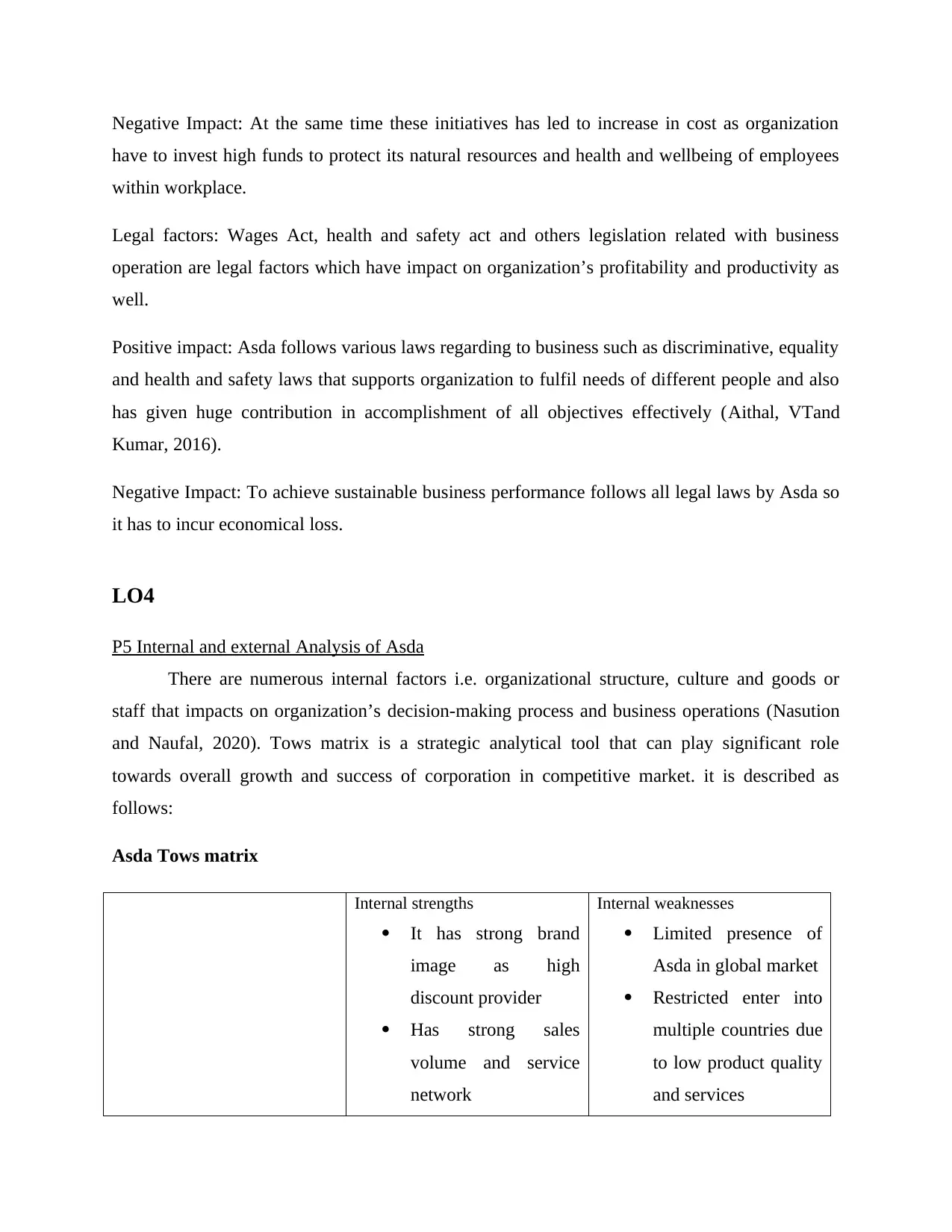
Negative Impact: At the same time these initiatives has led to increase in cost as organization
have to invest high funds to protect its natural resources and health and wellbeing of employees
within workplace.
Legal factors: Wages Act, health and safety act and others legislation related with business
operation are legal factors which have impact on organization’s profitability and productivity as
well.
Positive impact: Asda follows various laws regarding to business such as discriminative, equality
and health and safety laws that supports organization to fulfil needs of different people and also
has given huge contribution in accomplishment of all objectives effectively (Aithal, VTand
Kumar, 2016).
Negative Impact: To achieve sustainable business performance follows all legal laws by Asda so
it has to incur economical loss.
LO4
P5 Internal and external Analysis of Asda
There are numerous internal factors i.e. organizational structure, culture and goods or
staff that impacts on organization’s decision-making process and business operations (Nasution
and Naufal, 2020). Tows matrix is a strategic analytical tool that can play significant role
towards overall growth and success of corporation in competitive market. it is described as
follows:
Asda Tows matrix
Internal strengths
It has strong brand
image as high
discount provider
Has strong sales
volume and service
network
Internal weaknesses
Limited presence of
Asda in global market
Restricted enter into
multiple countries due
to low product quality
and services
have to invest high funds to protect its natural resources and health and wellbeing of employees
within workplace.
Legal factors: Wages Act, health and safety act and others legislation related with business
operation are legal factors which have impact on organization’s profitability and productivity as
well.
Positive impact: Asda follows various laws regarding to business such as discriminative, equality
and health and safety laws that supports organization to fulfil needs of different people and also
has given huge contribution in accomplishment of all objectives effectively (Aithal, VTand
Kumar, 2016).
Negative Impact: To achieve sustainable business performance follows all legal laws by Asda so
it has to incur economical loss.
LO4
P5 Internal and external Analysis of Asda
There are numerous internal factors i.e. organizational structure, culture and goods or
staff that impacts on organization’s decision-making process and business operations (Nasution
and Naufal, 2020). Tows matrix is a strategic analytical tool that can play significant role
towards overall growth and success of corporation in competitive market. it is described as
follows:
Asda Tows matrix
Internal strengths
It has strong brand
image as high
discount provider
Has strong sales
volume and service
network
Internal weaknesses
Limited presence of
Asda in global market
Restricted enter into
multiple countries due
to low product quality
and services
⊘ This is a preview!⊘
Do you want full access?
Subscribe today to unlock all pages.

Trusted by 1+ million students worldwide
1 out of 19
Related Documents
Your All-in-One AI-Powered Toolkit for Academic Success.
+13062052269
info@desklib.com
Available 24*7 on WhatsApp / Email
![[object Object]](/_next/static/media/star-bottom.7253800d.svg)
Unlock your academic potential
Copyright © 2020–2025 A2Z Services. All Rights Reserved. Developed and managed by ZUCOL.





